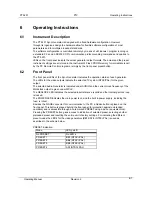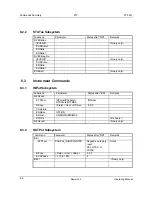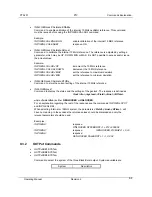
Remote Interface
PTV
PT 5201
Revision 2
Operating Manual
7-14
7.1.6
Command Syntax
A command consists of a “header” and one or several “parameters”. Header and parameters
are separated by space.
A header may consist of several keywords.
7.1.7
Syntax of Program Messages
A command or query is called a program message unit. Such a program message unit
consists of a header, or a header separated by a space from one or more parameters. The
program header separator between the header and the first parameter must be at least one
“white space” character. The header consists of one or more mnemonics (key words)
describing the command. The parameters in a message unit are also referred to as “Data
Elements”. They are mutually separated by a comma (,), which is referred to as “Data
Separator”. Furthermore the following rules are valid:
♦
Any one of the “white space” characters (dec. 0..9, 11.. 32) may:
−
precede a header
−
precede the Message Terminator
−
be placed in between the header and the parameter
−
be placed in between two consecutive parameters
♦
String data in a parameter must be specified between quotes. A quote may either be a
“single quote” (dec. 39) or a “double quote” character (dec. 34)
One or more program message units (commands) may be send within a single program
message. Program message units are separated by a semicolon (;). A message of one or
more units is terminated by a program message terminator.
The line feed character may be used as the program message terminator
♦
LF <line feed> (dec.10) code
Note
:
Most controller programming languages send the terminator automatically, but allow it to be
changed.
Basically there are two types of program headers:
♦
Compound headers
Commands have a compound header consisting of one of more key words (mnemonics),
mutually separated by a colon (:) character. Such as a colon may also precede the header.
♦
Command headers
The program messages that are standardized are called common commands. Their headers
always start with an asterisk (*) character
Each key word in a compound command header represents a node in the command tree. The
left most key word is the root node, representing the highest hierarchical level in the command
tree. Subsequent keyword represents sub nodes under the root node.
Summary of Contents for PT 5201 Compact VariTime
Page 6: ......
Page 20: ......
Page 40: ......
Page 56: ......
Page 63: ...PT 5210 PTV Operating Manual Revision 2 11 5 END OF DOCUMENT ...
















































